Is the arrangement of sun, planets and other solid objects in the space in relation to the position of the sun.
The planets are not arranged in a single line from the sun, they are scattered in the space.

1. Mercury = 57,600,000 km
2. Venus = 107,200,000 km
3. Earth = 148,800,000 km
4. Mars = 227,200,000 km
5. Jupiter = 772,800,000 km
6. Saturn = 1,417,600,000 km
7. Uranus = 2,854,400,000 km
8. Neptune = 4,468,800,000 km
A. SUN
Sun is the star. It is one among the millions of stars that one sees at night except that it looks much bigger because it is closer to the earth than other distant stars.
The sun is much larger than other distant stars from the earth, in fact much larger than all the planets put together. It’s diameter is approximately 1.4 million kilometers and its mass is approximately 330,000 times greater than that of the earth. The elements that form the material of the sun are also in different proportion from those of the earth.
The sun is composed of approximately;
– 75% hydrogen
– 23% helium
– 3% of other elements
The earth is relatively cold body but the sun is so hot that nearly all molecules are broken into their separate atoms and all are mixed together into a single hot gas. Its average surface temperature is about 60000c, it is much hotter in the interior where it is about 14,000,0000c.
The sun is the main source of all light and heat that the planets receive.
B. SOLAR ENERGY
The sun is the source of all energy in the earth. This is called solar energy. Solar energy is the energy produced by the sun
USES OF SOLAR ENERGY
Solar energy is used in many ways: –
1. In drying clothes, grains, fruits and meat.
2. Growing plants :- when plants grow they use energy from the sun to manufacture their food through the process known as photosynthesis
3. Solar energy captured in solar panels and stored in batteries provides electricity used in generating industrial and home
appliances like television, refrigerator, Oven, electric iron and cooker.
4. Many everyday items such as calculators and other low power consuming devices can be powered by solar energy effectively
5. Is used as a source of vitamin D for human being
6. It is used for evaporation of water from water bodies which is necessary for rain formation
Coal energy is the solar energy stored in the bodies of plants grew thousands of years ago,which after being barried under the earth for a very long time turned into coal similarly gas and oil formed from died bodies of organic matters which lived thousands of years ago.
HOW THE USE OF SOLAR ENERGY PROMOTES ENVIRONMENTAL CONSERVATION
1. Solar energy is used by plant during manufacturing its food through the photosynthesis. In this process plants take up carbon dioxide from the atmosphere and releasing oxygen. In doing so carbon dioxide is removed from the atmosphere making the ozone layer safe and more oxygen to be used in troposphere by other living organisms
2. More over, Solar energy is clean and safe type of energy suitable for heating and lighting. This is due to the fact that it does not release soot.
3. The use of solar energy in households helps to promote and conserve environment in the sense that it would reduce the need for firewood and charcoal, where by both once extracted pollute and destroy forest.
4. The use of solar energy also reduces the use of fuel like kerosene as a result it helps to reduce environmental pollution caused by smoke from burning fuel
SOLAR ENERGY IN RELATION TO THE EMANCIPATION OF WOMEN (HOW SOLAR ENERGY CONTRIBUTE TO THE EMANCIPATION OF WOMEN)
i) Helps to reduce the time would be consumed/used by the women searching firewood from forest.
ii) The use of solar energy equipments on cooking makes them to have more time to be involved in money making activities such as business or farming.
iii) Through the use of solar energy equipments in cooking and other domestics tasks, young girls get time to go to school and private study as it was to the boys.
C. PLANETS
The planets are bodies that revolve around the sun. They include:-
1. Mercury 4. Mars 7. Uranus
2. Venus 5. Jupiter 8. Neptune
3. Earth 6. Saturn
As they revolve around the sun they appear to move around the star. That is why the Greeks called them planets means “Wandering stars”. All planets revolve around the sun in the same orbit that are elliptical and nearly the same plane.
The time taken to complete an orbit round the sun depends on the distance of the planet from the sun. All the light and heat of the planets come from the sun. Hence the temperatures on the planet depend on their relative distances from the sun.
However, Pluto is not a planet because an object to be a planet, it needs to meet these requirements (criteria) defined by the International Astronomical Union (IAU) as follows:
i) It needs to be in orbit around the sun
ii) It needs to have enough to pull itself in a spherical shape
iii) It needs to have “Cleared neighborhood of its orbit”
Note: Any object that doesn’t meet this 3rd criteria is considered a dwarf planet. And so, Pluto is a dwarf planet is not a planet.
PLANETS POSITION AND CHARACTERISTICS
|
Planet |
Approximate distance from the sun |
No. Of moon per planet |
Average temperature |
Period per orbit |
|
Mercury |
58 million km |
0 |
340 0c |
88 days |
|
Venus |
108 million km |
0 |
40 0c |
225 days |
|
Earth |
150 million km |
1 |
– |
365.5 days |
|
Mars |
288 million km |
2 |
100 0c |
1 year and 322 days |
|
Jupiter |
777 million km |
16 |
138 0c |
11 years and 315 days |
|
Saturn |
1426 million km |
20 |
247 0c |
21 years and 167 days |
|
Uranus |
2869 million km |
15 |
200 0c |
84 years and 6 days |
|
Neptune |
4495 million km |
2 |
265 0c |
164 years and 288 days |
edu.uptymez.com
D. COMETS
Sometimes at night one sees objects with leading heads and right tail at the sky. These are called comets. At present many scientists believe that comets are composed of ice crystals and fragment matters. Comets revolve around the sun far beyond the limits of Pluto. They can be seen from the earth only when they come close to the sun.
E. ASTEROIDS
Asteroids are solid heavenly bodies revolving around the sun mostly between the orbits of Mars and Jupiter. There are thousands of these,the largest having diameter of less than 800km. These bodies cannot be seen without a telescope
because they are very far away.
F. METEORS
Meteors are process of hard matter falling from outer space become visible between 110 and 145 km above the earth’s surface, where as a result of friction with the atmosphere become hot and usually disintegrate. When they do completely disintegrate as they pass through the atmosphere reach the earth’s surface and are known as meteorites.
Meteorites are usually made of nickel, iron or silica fragments of disintegrated comets. There are two known meteorites in Tanzania one is found in Mbozi District and the other fell at Malampaka in Kwimba District in 1930.
Sometimes meteors reach the earth’s surface with such force, hence they make large holes or craters. An example of such craters in the world is the great meteor crater in Arizona desert in United states of America which is 150 meters deep and about 1 kilometer width.
G. SATELLITES
Satellites are moons of the planets. The number of satellites depend on the nature and size of planet up to the moment space researches have proved that only seven planets have satellites.
H. THE EARTH
We live on the planet earth. The Earth is made of the : –
– Atmosphere (air)
– Hydrosphere (water bodies)
– The crust solid
– Molten material
– Biosphere (living things)
About ¾ of the earth’s surface is covered by water. In fact no other planet in the solar system is known to have water bodies,the shape of the earth is a flattened sphere. This flattening is very slight as indicated by measurements in diameters through poles and at the equator. The diameter through the poles is 12,713 km while at the equator it is 12,757 km.
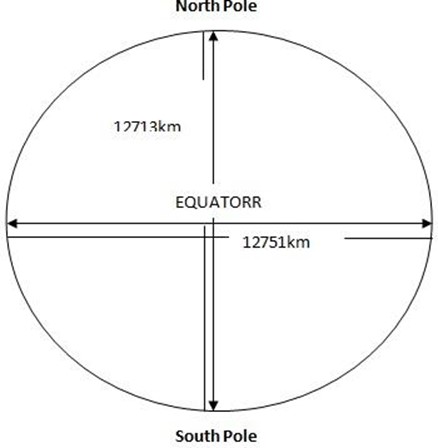
EVIDENCES OF THE EARTH’S SHAPE
There are some several evidences which are used to prove that the earth is sphere like structure, some of them are shown in the following: –
(i) SUNRISE AND SUNSET
The sunrise and sunset at different places of the earth, people in the east see the sun earlier than the people in the west due to earth’s rotation from west to east. If the earth was flat the whole world would have sunrise and sunset at the same time.
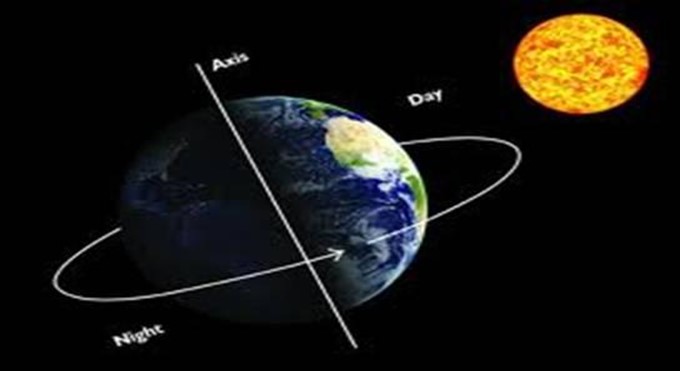
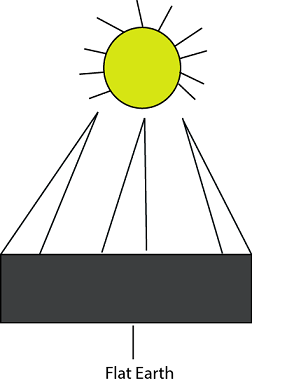
(ii) CIRCUMNAVIGATION OF THE EARTH
If traveling from a certain point of the earth and you go straight around the earth you will come to the point of origin. The first traveler around the world named Magellan in 1519-1522 proved this, image did not encounter abrupt edge over the world in his voyage.
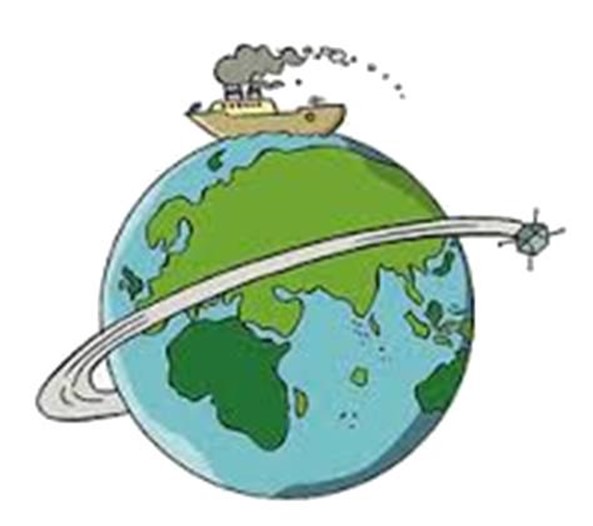
(iii) AERIAL PHOTOGRAPHS
Photographs taken by satellites or aeroplane from the air show that the earth has a curved or round shape.
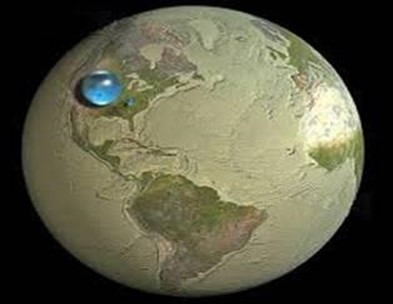
(iv) SHIP’S VISIBILITY
If you are in the coast viewing a ship which is very far you will see the soot, then the pipe and eventually the whole ship gradually appears. If the earth were flat the ship would have been seen all at once
SPHERICAL EARTH
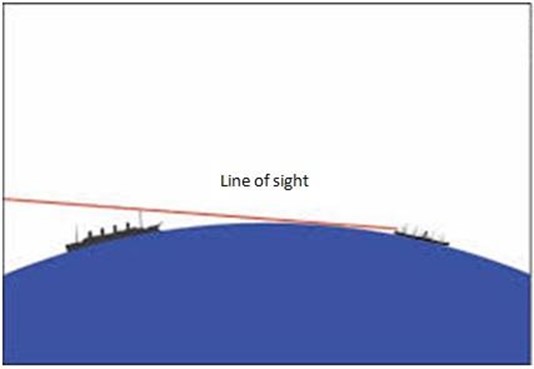
FLAT EARTH
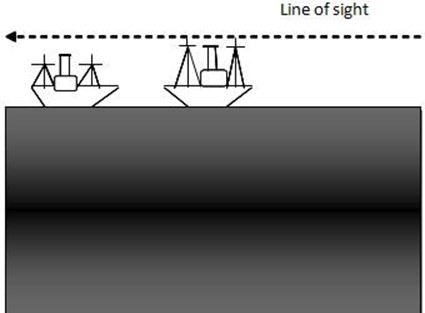
(v) LUNAR ECLIPSE
The shadow of the earth thrown to the moon during lunar eclipse is always round. Only a spherical object can give a circular shadow.


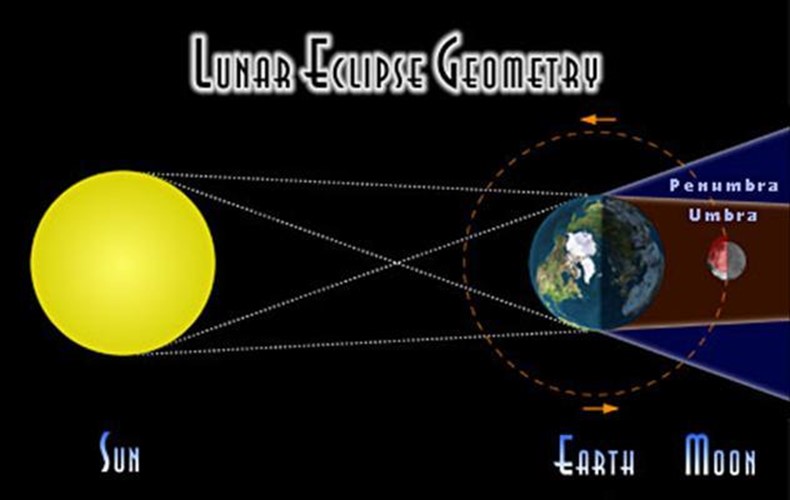
THE MOON
The moon is a natural satellite of the earth. It has a solid spherical body with a diameter of 3456 kilometers. The distance from the earth to the moon is a 384,403 kilometers. The moon takes l29 ½ days to make a complete revolution around the earth .
The moon appears to rise in the east and set in the west because the earth spins from west to east.
Among all planets only the earth sustains life due to its position from the sun. It is not very close or very far from the sun.
Other bodies such as Pluto which is very far from the sun does not sustain life because it is very cold. Likewise Mercury which is very close to the sun does not sustain life because it is very hot.
Exercise 1
1. Define the following terms
(i) Solar system -Is an arrangement of the sun,planets and solid objects in the space in relation to the position of the sun.
(ii) The sun – Sun is a big star.
(iii) Solar energy – Is an energy produced by the sun.
(iv) The planets – Are bodies that revolve around the sun.
(v) Comets – Are the objects with leading heads and bright tail on the sky.
(vi) Asteroids – Are solid heavenly bodies revolving around the sun mostly between the orbits of Mars and Jupiter.
(vii) Meteors – Are process of hard matter falling from outer space.
(viii) Meteorites – Are usually made of nickel, iron or silica fragments of disintegrated comets.
(ix) Satellite – Are moons of the planet.
2. List down four uses of solar energy;
(i) It is used for domestic purposes. e.g. For cooking, to generate electricity, etc.
(ii) It is used as a source of vitamin D for human being
(iii) It is used for manufacturing of food to the plants
(iv) It is used for evaporation of water from water bodies which is necessary for rain formation
3. Mention five evidences which are used to prove that the earth is sphere like;
(i) Sunrise and sunset
(ii) Circumnavigation of the earth
(iii) Aerial photographs
(iv) Ship’s visibility
(v) Lunar eclipse
EARTH’S MOVEMENT
The earth is in motion all the time. One does not feel this motion because one moves with it, like all other planets, the earth has two motions known as: –
(a) Rotation
(b) Revolution
ROTATION
Rotation is the spinning of a body on its axis.
Earth’s rotation – is a spinning of the earth on its axis.
Axis – is an imaginary line joining the north and south poles through the center of the earth
The earth’s axis makes an angle of 660 from the perpendicular. The earth rotates on its
Axis from west to east.
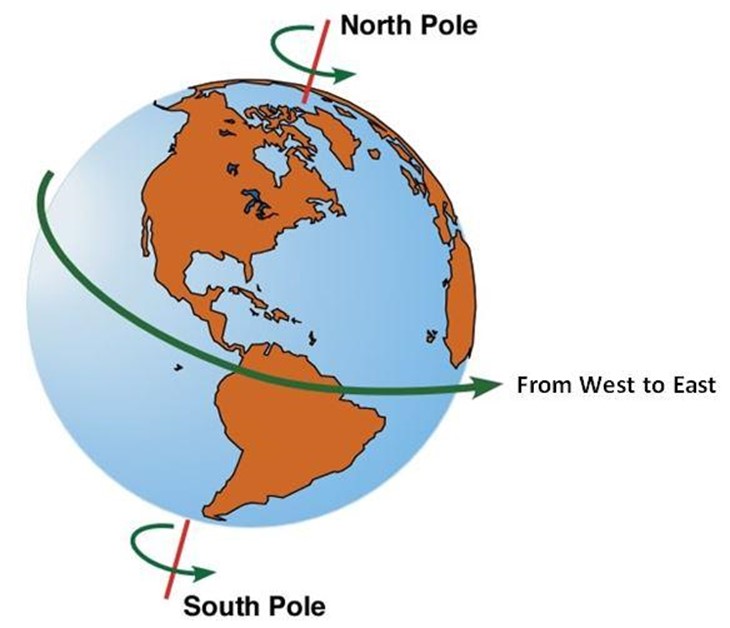
It makes one complete rotation after every twenty four hours or one day, the following observations illustrates the earth’s rotation from west to east;
1. When traveling in a fast moving vehicle we notice trees and other objects on both sides of the road moving in the opposite direction. This observation is similar to the movement of the earth’s rotation to the sun.
2. In the morning the sun appears to rise over the eastern horizon but due to the fact that the sun is the center of the solar system we know that it does not move in relation to the solar system. This shows that the earth is moving from west to east.
3. At night most of the stars appear to move across the sky from east to west. This shows that the earth is moving from west to east.
ROTATION OF THE EARTH CAUSES/ EVIDENCE TO PROVE THAT THE EARTH ROTATES;
– Day and night
– Different hours
– Deflection of winds and ocean currents
– Daily rising and falling of tides
A: DAY AND NIGHT
When the earth rotates, it causes day and night. The side that faces the sun will be expecting day light while the side that is not facing the sun at that time will be in darkness.Therefore as the earth rotates its parts come alternatively in the light pass out of it again.
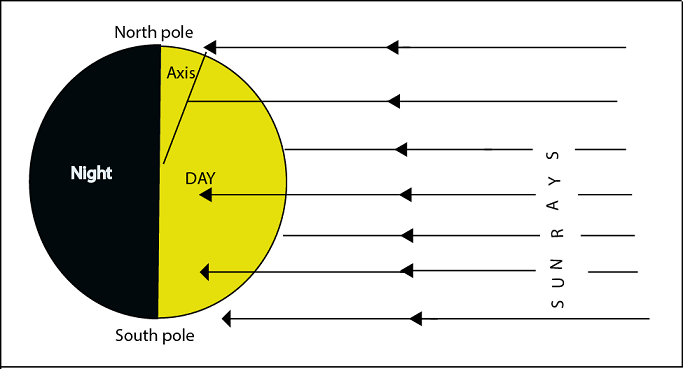
Exercise 2
1. What is rotation?
Rotation is the spinning of a body on its axis
2. What is the earth’s axis?
The earth’s axis is an imaginary line joining the north and south pole through the center of the earth.
3. Mention the degrees of the earth’s axis
Earth’s axis it makes 660 degrees.
4. What is the direction of the earth rotation? From west to east.
5. What time is used by the earth to make one complete rotation? 24 hours or one day.
6. Mention four causes of the earth’s rotation
(i) Day and night
(ii) Different hours
(iii) Deflection of wind and ocean currents.
(iv) Daily rising and falling of tides.
REVOLUTION
Is the movement of one body around another.
Earth’s revolution: –
– Is the movement of the earth around the sun
– The earth takes 365 ¼ days for a complete revolution
– When the earth takes 366 days to accomplish one revolution is called a Leap year
– The earth revolution revolve around the sun in an elliptical
– Due to the shape of the earth’s orbit, the earth is very closer to the sun at one point of the year than at another.
APHELION AND PERIHELION
Aphelion is the furthest position of the earth’s orbit from the sun.
– The earth is at Aphelion each year on 4th July when it is in 152 million kilometers from the sun.
Perihelion is the nearest position of the earth from the sun.
– The earth is at perihelion each year on 3rd January when it is 147.3 million kilometers from the sun.
Therefore the speed of revolution is about 29.66 km per second.
REVOLUTION
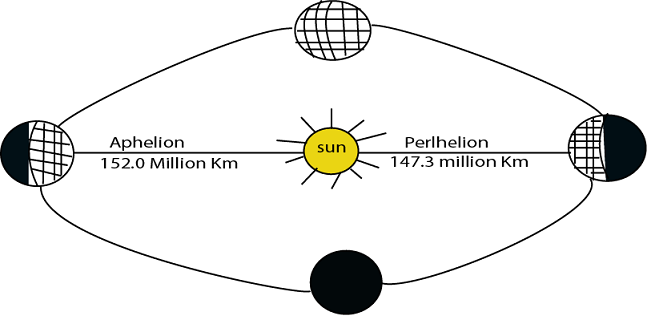
THE EFFECTS OF EARTH’S REVOLUTION
When the earth revolves around the sun it causes: –
(a) Seasons of the year
(b) Eclipse
(c) Difference in the length of day and night
(d) Change of midday sun in the latitudes.
Exercise 3
1. To define the following terms
(a) Rotation
Is the spinning of a body on its axis.
(b) Earth rotation
Is the spinning of the earth on its axis.
(c) Axis
Is an imaginary line spinning the north and south poles through the center of the earth.
(d) Revolution
Is the movement of one body around another.
(e) Earth revolution
Is the movement of the earth around the sun.
(f) Aphelion
Is the furthest position of the earth’s orbit from the sun.
(g) Perihelion
Is the nearest position of the earth from the sun
2. Mention 4 effects of earth’s rotation
(i) Day and night
(ii) different hours
(iii) Deflection of wind ocean currents
(iv) Daily rising and falling of tides
3. List down 4 effects of earth’s revolution
(i) Seasons of the year
(ii) Eclipse
(iii) difference in the length of day and night
(iv) change of midday sun in the latitude
4. What causes of day and night?
The day and night; the side that faces the sun will be experiencing day light while the side that is not facing the sun at that time will be in darkness.
5. To mention three observations illustrate the earth rotation from west to east
(i) it makes one complete rotation every twenty four hours or one day
(ii) At night most of stars appear to move across the sky from west to east
(iii) In the morning the sun appear to rise over the eastern horizon due to the fact that the sun is the center of solar system.
SEASONS
Season is one of the four periods of the year separated from each other by different temperature conditions. The seasons are summer, autumn, winter and spring. They are more pronounced between 230c and 660c of latitudes. At the equator the year is divided between hot and wet seasons while at the poles is very cold all the year around and the season cannot be identified easily.
The Northern hemisphere summer months are May, June and July. Autumn months are August, September and October, Winter Months are November, December and January while spring months are February, March and April. In the Southern Hemisphere summer months are November, December and January, Autumn months are February, March and April Winter has May, June and July while spring months are August , September and October.
CAUSE OF SEASONS
Seasons are caused by inclination of the earth’s axis and the earth’s revolution around the sun. The earth’s axis is tilted at an angle of 660 to the earth’s orbital plane and it is always pointing to the same direction in space. In its revolution around the sun one of the hemispheres is inclined towards the sun to one period of the year and away from it at another period of the year.
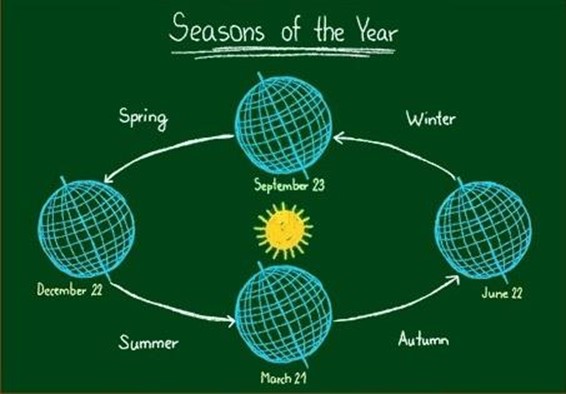
ECLIPSE
This is the movement of one heavily body between the two others, such that it casts shadow over the other.
The eclipse involves three heavily bodies namely; the Sun, the Earth and the Moon. So long as the sun is the central body of the solar system, it never moves, only the earth and the moon are in the motion all the time.
An eclipse is said to be total eclipse when the whole body is obscured i.e completely blocked from the sun light and it is described as a partial eclipse when the only part of the body becomes obscured. At any place an eclipse will last short time, hardly seven minutes because both the earth and the moon are in motion.
TYPES OF ECLIPSE
There are two types of eclipse i.e Lunar eclipse and solar eclipse
LUNAR ECLIPSE (ECLIPSE OF THE MOON)
This occurs when the earth moves between the sun and the moon, this casting its shadow over the moon.
ECLIPSE OF THE MOON
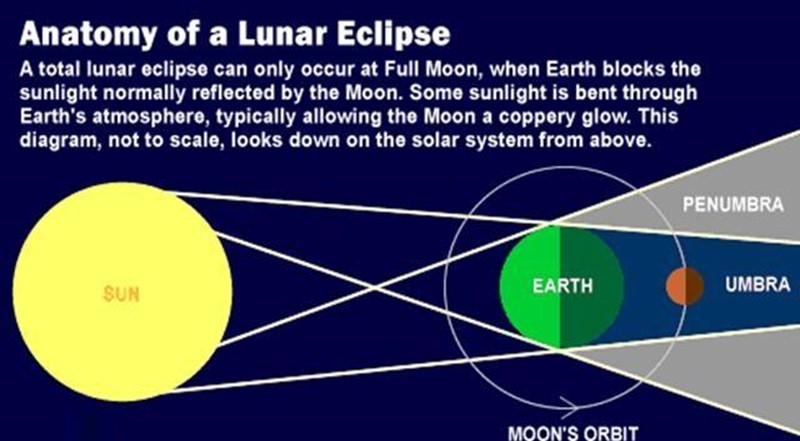
THE SOLAR ECLIPSE
The solar eclipse is also known as the eclipse of the sun.
This occurs when the moon passes between the earth and the sun casting its shadow over the earth.
THE SOLAR ECLIPSE
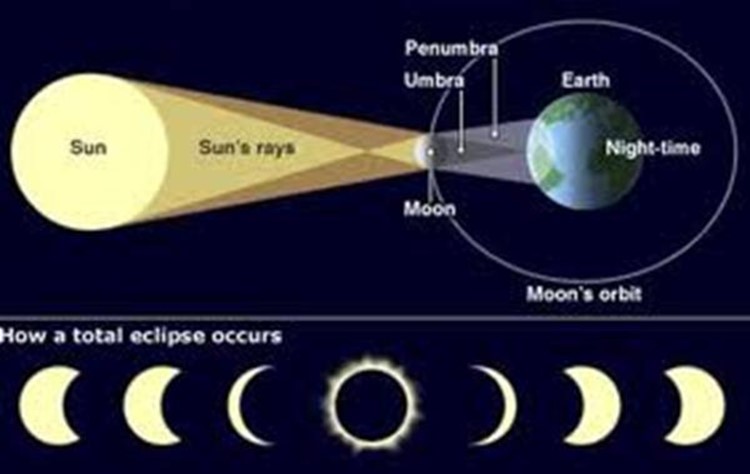
Umbra or total eclipse is when the whole body is obscured i.e completely blocked from the sun’s light.
Penumbra or partial eclipse is when only part of the body becomes obscured.
Exercise 4
1. Define the following terms.
Eclipse
Is the movement of one heavily body between two others such that it casts shadow over the other.
Lunar eclipse
This occurs when the earth moves between the sun and the moon thus casting its shadow over the moon.
Solar eclipse
Is also known as the eclipse of the sun. This occurs when the moon passes between the earth and the sun,thus casting its shadow over the earth.
Penumbra
Is when only part of the body becomes obscured.
Umbra
Is when the whole body is obscured i.e completely blocked from the sun’s light.
Seasons
Is one of the four periods of the year separated from the other by different temperature conditions.
2. Mention 4 seasons of the year
(I) Summer
(II) Autumn
(III) Winter
(IV) Spring
At any place an eclipse will last for short time or hardly seven minutes
THE APPARENT MOVEMENT OF THE OVERHEAD SUN
The apparent movement of the overhead sun is related to the different positions of the earth on its movement as it revolves around the sun. The overhead sun appears to move north wards and south wards in an osculating (swinging) manner.
However the overhead sun’s northward limit is latitude 230N. People beyond this latitude never see the sun vertically above their head . The latitudes 230N is known as Tropical of cancer . Similarly the overhead sun ends 230S in its apparent Southward movement. This latitude is known as the Tropic of Capricorn on 21st June the sun is vertically overhead on the Tropical of cancer. This is known as the summer solstice in the Northern hemisphere.
On 22nd December the sun is vertically overhead on the Tropic of Capricorn this is the winter solstice in the Northern Hemisphere.
Solstice means equal night or is when the sun on these days appears to stand still between its north ward and southward journeys.
WINTER SOLSTICE
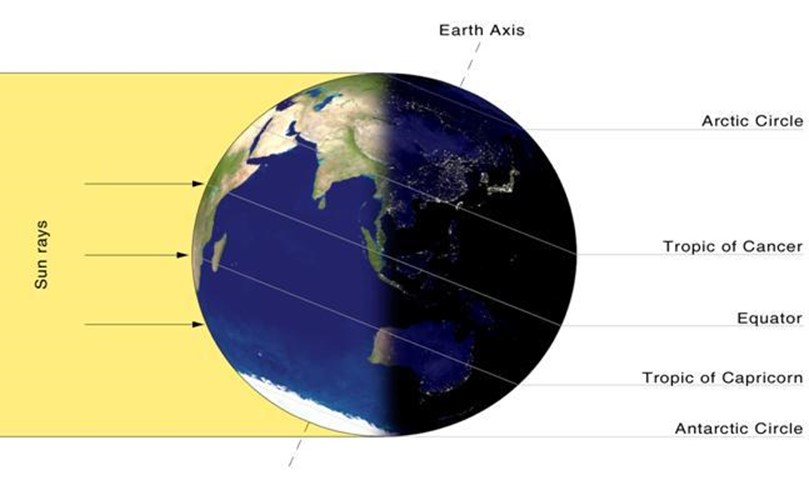
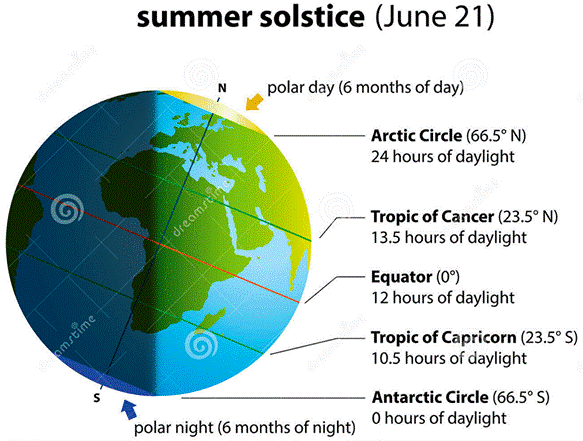
THE SOLSTICES
The sun is overhead twice a year at the equators 21st March and 23rd September. 21st March is known as the Spring equinox and 23rd September is known as the autumn equinox in the Northern Hemisphere.
Equinox means equal nights, at equinox the length of day and night is equal over all places on the earth’s surface. Viewed from the Southern Hemisphere the solstices and the equinoxes are reversed.
LENGTH OF DAY AND NIGHT
Places along the equator experience equal day and night all the year, but north wards or south wards towards the poles, the length of day and night vary with latitudes. For instance in Northern Summer when the Northern Hemisphere is inclined towards the sun, days are longer than nights. However at latitude 660N known as the Arctic. Cycle and beyond the sun appears around the sky without setting. in the North pole day light is experienced for six months before the sunset.
Then this region remains in darkness for the next six months, Latitude 66° south is known as the Antarctic cycle.
The polar regions south of the Antarctic cycle experience the long six months night from March to September and the six months day light from October to February.
PARALLELS AND MERIDIANS.
Parallels are more commonly known as Latitudes
Latitude/Parallel
The arc or angular distances(measured in degree minutes and seconds) of a point on the surface north or south of the earth from the equator.
Meridians: Are commonly known as Longitude.
Longitude/Meridian: Is angular distance measured in degrees East or west of the prime meridian, they run from north to south.
THE IMPORTANCE OF PARALLEL AND MERIDIANS
a) Longitudes (meridian) enable us to calculate local and International times of different places on the earth/s surface.
b) Latitudes (parallel) help us to to explain and understand the variation in climate on the surface of the earth.
c) Parallel and meridians are used by pilots and sailors to guide their path.
d) They enable us to locate places on maps, for example Tanzania is found at Latitude 6°00′S of the equator and Longitude
35°00′ E of Greenwich meridian.
LATITUDE AND LONGITUDE
Latitude:
Is the angular distance north or south of the equator measured in degrees, minutes and seconds.
OR
Are the lines drawn on a map from east to west.
– The equator is latitude of 0°
– The equator divides the earth into two equal parts (Hemisphere)
– The hemisphere north of the equator is northern hemisphere
– The hemisphere south of the equator is known as Southern hemisphere
– Latitude are also known as a parallel lines of equator because they never meet.
– The lines of latitude are measured from 00 (the equator) to 900 north and south.
LINES OF LATITUDE ARE
– The equator 00
– The tropical of cancer 23 ½0N
– The Tropical of Capricorn 23 ½0S
– Arctic cycle 66 ½0N
– Antarctic cycle 66 ½0S
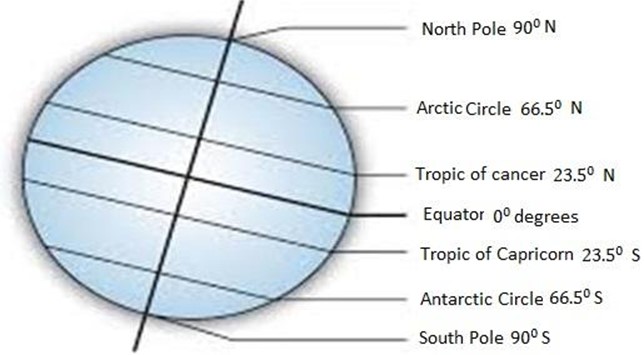
PARALLEL OF LATITUDE 300N
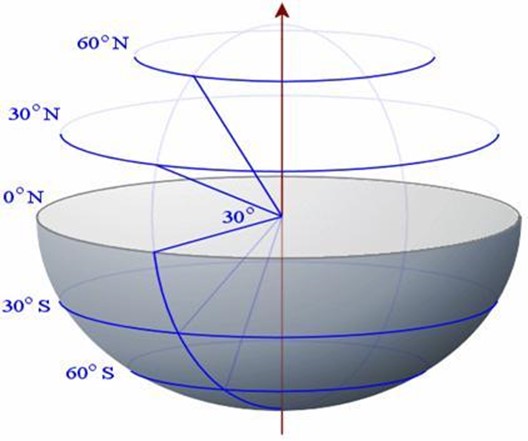
Longitude
Is an angular distance measured in degrees east or west of the prime meridian, they run from north to south.
Greenwich is a longitude 00 . It is also known as prime meridian.
The prime meridian is the line running through the poles (North and South) and is known as greenwich 00
Longitudes are measured from 00 to 1800 East or West of greenwich, all meridians are passing through the North and south poles.
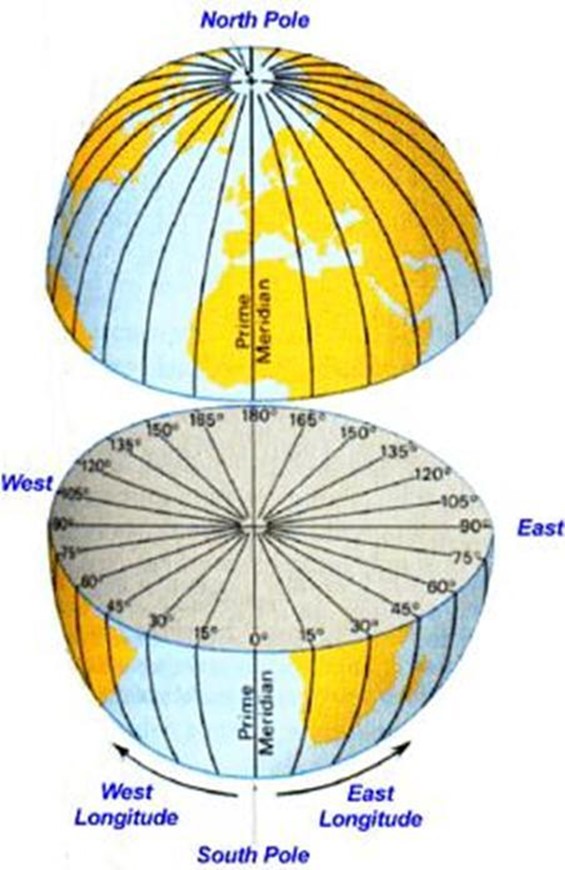
LONGITUDE AND TIME
The earth rotates on its own axis from west to east once every twenty four hours (one day). This means that the earth turns through 3600 in twenty four hours.
All places along a given meridian will experience midday along the same meridian, it is known as Local Mean, on the Greenwich meridian is known as Local Mean Time (LMT).
When it is 12:00 noon, on the greenwhich meridian it will be 1:00 pm at a place of 150E or 11:00 at a place of 150W.
To find time for example for Musoma in Tanzania (340) when it is 12:00 in Kinshasa Zaire
1. Note the longitude position of Kinshasa 150 300E and Musoma 340
2. Find the difference in degree of longitude between Kinshasa and Zaire
340 – 15030 = 18 ½
3. Find the difference in time between Kinshasa and Zaire
18 ½ x 4 = 1 7/30 or 1 hour and 14minutes
60
OR,
1° = 4 minutes
18 ½ = x
x= 4 X 18 ½ = 1 hour and 14 minutes.
1
4. Since Musoma is to the east of Kinshasa , Musoma time will be ahead of that of Kinshasa by 1 hour and 14 minutes therefore time for Musoma will be 12:00 +1:14 = 13:14 pm Or 1:14 pm.
In the other hand, given the time difference between two places and the longitude of one of them, one can calculate the longitude position of the second places Kinshasa 150 300 and 1 hour and 14 minutes. behind the time of Musoma.
Find the longitude position of Musoma
Difference in time between Musoma and Kinshansa 1 hour and 14 minutes.
Difference in degrees of longitude between Musoma and Kinshansa is 1hr and 14 minutes = 74/4 or 180 300
Since the time of Kinshasa is behind that of Musoma, Musoma must be east of Kinshansa. Therefore the longitudinal position of Musoma will be 150 30′ + 180 30′ = 340E.
GREAT CIRCLE
The intersection of the surface of a sphere and a plane through its centers for example meridians of longitude and equator are great circle in the earth’s surface. Therefore there is no limit to the number of great circle that can be drawn.
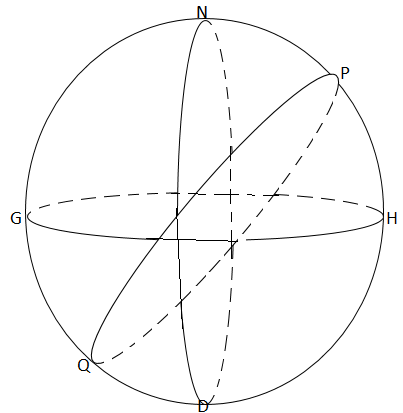
Great circle also is a circle drawn on a globe (or other sphere) with a center that includes the center of the globe. Thus a great circle divides the globe into two equal halves.
IMPORTANCE OF GREAT CIRCLE
i) The great circles are important for aeroplanes which use them as route ways to guide their path
ii) Great circles are important for ship to follow routes along great circles
TIME.
Refers to a period that is used for a event or activity. It is measured in seconds, minutes, hours, days, months or years.
TIME ZONES
Is the region having the same standard time. Standard time is common on time for all countries belonging to the same time zone for example, Tanzania, Kenya, Uganda,Ethiopia, Djibouti and Somalia use the same standard time. This is commonly referred to a the East African Standard time.
There would be problems of telling time if every place had its own time set according to local mean time.For example, there would be
great confusion in railway and airway time table or in radio programs if they had to show difference time each one place within a small area. To avoid this problem, different stretches of land take their time from great Meridian. The time adopted is known as STANDARD TIME.
In East Africa, standard time is taken from meridian of 450E when a whole stretch of land keeps to the same standard time that stretches
from a time zone . Therefore time zone refers to a stretch of land where standard time is accepted through out a longitudinal zone 150 width.
Countries with large stretches of land have several standard time zones.There are 24 time zones in the world. The greenwhich Meridian is the starting point for dividing the globe into 24 time zones, the standard time for Greenwich is known as the Greenwich Mean Time (GMT).
Essence of Time Zone
– In a certain place there could be a place on the surface using its’ own local time. This would brought a lot of confusion example every radio station would have to announce different times for every region within the same country: Local time of Bukoba would be different from that of Dodoma.
– The above confusion was avoid when it was internationally agreed to split the world into 24 time zone according to Longitudes
– The longitudinal division across the earth with an approximates with of 15° of longitude which is regular across the oceans.
– Each time zone has a standard time which is the time of the longitude(meridian near the center of time zone. In the same way, all countries belonging to the same time zone have common time.
Note: Large countries like Canada, USA and Russia have different standard times for different regions within them because they are crossed by many time zone
Exercise 5
1. If it is 9:30 am at kasse 330 150E what time is in Zanzibar 450 150E?
450 .150
-330 . 150
12 . 00
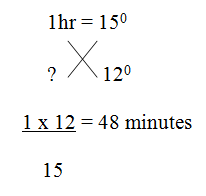
9.30 am
0.48
10.18 = 10.18 minutes
2. Find the time for the youncle 30°w if it is 12.00 noon London
30° – 0° = 30°

15 = 300 x 1hr = 2hr
15 15
12.00
– 2.00
10.00
= 10.00 a.m
3. When it is 3.30pm at Nairobi (250E) what is the time for Comoro 1200E?

1hr x950 = 950 = 6 1/3x 60
15 15
= 6hrs and 20 minutes
3.30
+ 6.20
9.50 p.m
INTERNATIONAL DATE LINE.
The line where date is changed or where the calendar day begins.
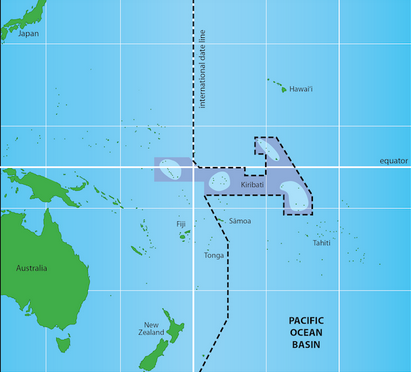
One travels eastwards and cross the date line, one will gain a day, if one travels westwards and cross the date line, one will lose a day, if Greenwich it is noon on Tuesday a place 900w would be 10am on Tuesday, at a place 1800w it would be midnight Monday . On the other hand a place 900E would be 6.00pm on Tuesday and at a place 1800E would be midnight on Tuesday.
